| Golden
Age Technologies |
Bioplastics -
Potentials and Perspectives
By Duisburg News Group (Originally in German)
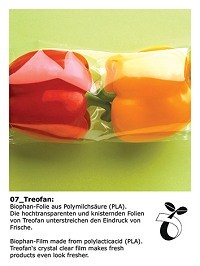 |
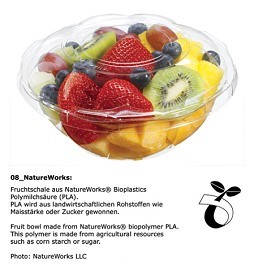 |
| Biophan-Film made from polylacticacid (PLA). It makes the fresh product look even fresher. (Photo: Treofan) | A fruit bowl made from NatureWorks® biopolymer PLA. This polymer originates from resources such as corn starch or sugar. (Photo: NatureWorks LLC) |
What is the fate of a plastic soda bottle that is thrown away and not recycled? It is crushed and shredded until it likely makes its way to the oceans where, broken down into tiny particles, it then ends up inside of living organisms: a danger for our environment. Something in this picture is not right. Hanswerner Mackwitz, the director of the Alchemia-Nova Research Institute for Innovative Phyto Chemistry in Vienna, Austria puts it like this: “When I manufacture a plastic product that has a half life of 450 years and yet use it for only a few weeks or days, then something is wrong.”1
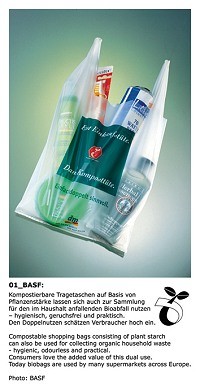 |
| A shopping bag derived from plant starch. Bags of this kind are used by many supermarkets across Europe. They are hygienic, odorless and practical and decompose with compost. (Photo: BASF) |
New technologies and even finished products have dealt with this dilemma in the form of bioplastic. Raw materials for bioplastics are the starches and oils from plant sources such as corn or sugar beets. Today we have the capacity to manufacture plant based molecular chains that are on a par with their petroleum based counterparts. Under certain conditions, most bioplastic materials completely decompose within 8 to 12 weeks.2
The fact that we are rapidly approaching global peak oil3, (the point at which the planet reaches the maximum oil production and after which the rate of oil production on Earth will enter a terminal decline) and thus the disappearance of cheap petroleum as the basis for plastics could mean that this new generation of packaging is on the rise. PLA (polylactic acid) plastics could replace the very successful PET (polyethylenterephthalat) plastics, although it is currently 20% more expensive.
The market for plastics is growing at 5% per annum. Every year, more than 200 million tons of plastics are produced worldwide. In Germany, 14 million tons of various packaging are produced every year and plastics make up 40% of the total. 1.8 million tons are destined for short-term use such as bags and disposable containers. The potential for bioplastics in Europe is up to 6 million tons of disposable packaging4, yet its market share of the total plastic consumption is still less than 1%. European Bioplastics representing the bioplastics industry in Europe states that the market boomed in 2006. As biopackaging is introduced to supermarket chains throughout Europe, the manufacturers expect a growth up to 100% in 2007 compared to 2006.5
Bioplastic packaging is already available in supermarkets in England, the Netherlands, Italy and Austria. Such plastics offer a higher permeability of oxygen and water evaporation than do traditional plastics and this characteristic keeps fruits and vegetables fresh for at least three additional days. Great Britain is playing a leading role in finding practical applications for bioplastics. In that country, organic salads and veggies have been sold in plastic containers made of renewable resources since the BSE scandal. The slogan has been “Organics come in organic packaging.”
The project in Upper Austria known as Loop Linz has been in operation since Golden Year 2 (2005). It aims to bring sustainable packaging to the market and is supported by the regional government as well as other organizations. Loop Linz was initiated by the above mentioned Research Institute for Innovate Phytochemistry and has demonstrated that this technology already works on a practical level. Various items in supermarkets are sold in the new bioplastic packaging made of plant starches. The production of this new packaging results in 50% less CO2 output.6
The company Pro-Tech7 has already launched biodegradable eating utensils made of renewable materials8. Gardeners are also able to purchase 100% biodegradable sheeting that serves as mulch and is available either from specialty stores or online.9
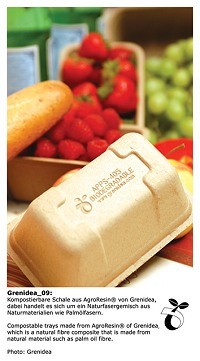 |
 |
| Compostable trays made of AgroResin® of Grenidea, which is a natural fiber composite that is made from natural material such as palm oil fiber (Photo: Grenidea) | A Walkman casing based on bio-polymers was launched by Mitsubishi and Sony in Japan. These new materials are also being explored by Nokia and Motorola. (Photo: Kaeb) |
 |
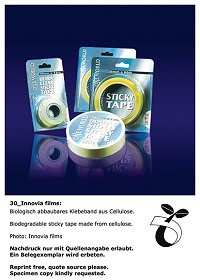 |
| A winter coat made of 100% corn. Versace uses Ingeo® fibre extruded form NatureWorks PLA. (Photo: GB Studio) | Biodegradable sticky tapes. (Photo: Innovia films) |
To gain a perspective into future developments, we go back again to Hanswerner Mackwitz from the Research Institute for Innovate Phytochemistry in Vienna: “We envision a successful polyculture with an intelligent management of the flow of materials from plants, soil and beneficial organisms that makes even greater use of the crop matrix.” For example in Austria, we have many stone fruits but have made use only of the flesh of the fruit, not the stone. That would change. The hard outer core of the seed can be transformed into an abrasive which can be used to polish metals for example. The soft interior of the seed can be turned into high grade oil or into cosmetics. These are “treasures” that up to now have gone to waste. The idea is to observe a plant as an entity in its environment. How can we make utmost use of the plant? For example, up to now we have only used the seeds of the sunflower plant and the fruit and wood from fruit trees. But what is contained in the blossoms, fruit, seeds, roots, stems and leaves? Knowledge of the plant’s biology will help to develop systems that make use of new material flows. The goal is “to develop solutions that are oriented to a particular region and are utilized with a cascade effect.”4
We are at the beginning of the Golden Age and it is now time
to harmonize with Mother Nature, especially in terms of our resources.
The technology is here and is waiting to be implemented by humans in a
wise and responsible way. We owe it to our home planet and to our children.
![]()
References:
1 http://www.faktor-x.info/cms.php?id=1129
2 http://de.wikipedia.org/wiki/Biokunststoff
3 (the point at which the planet reaches the maximum oil production and after which the rate of oil production on Earth will enter a terminal decline) Translator’s Note http://www.dematerialisierung.de/cms.php?id=1106
4 http://www.faktor-x.info/cms.php?id=1123
5 http://www.european-bioplastics.org/media/files/docs/en-pr/061121_PR_Bioplastics_Boom.pdf
7 http://www.pro-tech.info/english/ehome.htm
| << | Contents | >> |
| Refer
this page to friends |
||